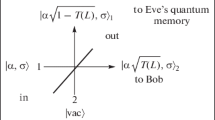Abstract
The cryptographic robustness of quantum key distribution (QKD) with phase–time coding against a photon number splitting (PNS) attack is analyzed. The line length up to which a secret key distribution is guaranteed is determined both by the protocol itself and by the efficiency of error correction in raw keys. The effect of different parameters of avalanche single-photon detectors on the length of the secret key distribution line is investigated. To correct errors, various versions of low-density parity-check (LDPC) codes are considered whose efficiency today is the closest to the Shannon theoretical limit.







Similar content being viewed by others
Notes
Note that state (1) is a single-mode, formally infinitely large state. In a real situation, one uses packages localized in a time window with characteristic length of about 1 ns and spectrum width of 109 Hz. Since optical elements in quantum cryptography systems are almost linear and dispersionless (components of states with different frequencies are transformed identically) in this range, it suffices to consider states with a single wavelength.
REFERENCES
C. H. Bennett and G. Brassard, in Proceedings of the IEEE International Conference on Computers, Systems and Signal Processing, Bangalore, India, 1984, p. 175.
M. Tomamichel, Ch. Ci Wen Lim, N. Gisin, and R. Renner, Nat. Commun. 3, 1 (2012).
A. N. Klimov, K. A. Balygin, and S. N. Molotkov, Laser Phys. Lett. 15, 075207 (2018).
K. A. Balygin, A. N. Klimov, I. B. Bobrov, K. S. Kravtsov, S. P. Kulik, and S. N. Molotkov, Laser Phys. Lett. 15, 095203 (2018).
L. Lydersen, C. Wiechers, Ch. Wittmann, D. Elser, J. Skaar, and V. Makarov, Nat. Photon. 4, 686 (2010).
G. Brassard, N. Lütkenhaus, T. Mor, and B. C. Sanders, Phys. Rev. Lett. 85, 1330 (2000).
Won-Young Hwang, arXiv[quant-ph]:0211153.
Xiang-Bin Wang, Phys. Rev. Lett. 94, 230503 (2005).
Hoi-Kwong Lo, Xiongfeng Ma, and Kai Chen, Phys. Rev. Lett. 94, 230504 (2005).
Xiongfeng Ma, Bing Qi, Yi Zhao, and Hoi-Kwong Lo, arXiv:0503005 [quant-ph].
Yi Zhao, Bing Qi, Xiongfeng Ma, Hoi-Kwong Lo, andLi Qian, arXiv:0503192 [quant-ph].
D. Rosenberg, J. W. Harrington, P. R. Rice, P. A. Hiskett, C. G. Peterson, R. J. Hughes, A. E. Lita, Sae Woo Nam, and J. E. Nordholt, Phys. Rev. Lett. 98, 010503 (2007).
B. Fröhlich, J. F. Dynes, M. Lucamarini, A. W. Sharpe, Zh. Yuan, and A. J. Shields, Nature (London, U.K.) 501, 69 (2013).
M. Lucamarini, K. A. Patel, J. F. Dynes, B. Fröhlich, A. W. Sharpe, A. R. Dixon, Z. L. Yuan, R. V. Penty, and A. J. Shields, Opt. Express 21, 24550 (2013).
Sellami Ali, Shuhairi Saharudin, and M. R. B. Wahiddin, Am. J. Eng. Appl. Sci. 2, 694 (2009).
Ch. Ci Wen Lim, M. Curty, N. Walenta, Feihu Xu, and H. Zbinden, Phys. Rev. A 89, 022307 (2014); arXiv:1311.7129 [quant-ph].
F. Xu, Sh. Sajeed, S. Kaiser, Zh. Tang, V. Makarov, and Hoi-Kwong Lo, Phys. Rev. A 92, 032305 (2014).
Zh. Zhang, Q. Zhao, M. Razavi, and Xi. Ma, Phys. Rev. A 95, 012333 (2017).
D. Gottesman, H.-K. Lo, N. Lütkenhaus, and J. Preskill, Quant. Inf. Comp. 4, 325 (2004).
S. N. Molotkov, J. Exp. Theor. Phys. 106, 1 (2008).
S. N. Molotkov, JETP Lett. 102, 473 (2015).
S. N. Molotkov, K. S. Kravtsov, and M. I. Ryzhkin, J. Exp. Theor. Phys. 128 (4) (2019, in press).
R. Gallager, IRE Trans. Inf. Theory 8, 21 (1962).
R. G. Gallager, Low-Density Parity-Check Codes (MIT Press, Cambridge, 1963).
R. Renner, PhD Thesis (ETH Zürich, 2005); arXiv:0512258 [quant-ph].
M. A. Nielsen and I. L. Chuang, Quantum Computation and Quantum Information (Cambridge Univ. Press, Cambridge, 2010).
T. J. Richardson and R. L. Urbanke, IEEE Trans. Inf. Theory 47, 599 (2001).
D. J. MacKay and R. Neal, Electron. Lett. 32, 1645 (1996).
D. J. MacKay, IEEE Trans. Inf. Theory 45, 399 (1999).
D. J. MacKay, Information Theory, Inference, and Learning Algorithms (Cambridge Univ. Press, Cambridge, 2003).
S. J. Johnson, Introducing Low-Density Parity-Check Codes (School of Electr. Eng. Comput. Sci., Univ. of Newcastle, Australia, 2006).
R. G. Gallager, Information Theory and Reliable Communication (Wiley, New York, London, Sydney, Toronto, 1968).
J. Martinez Mateo, PhD Thesis (Univ. Politéc. Madrid, Madrid, 2011).
D. Elkouss Coronas, PhD Dissertation (Univ. Politéc. Madrid, Madrid, 2011).
D. Elkouss, J. Martinez-Mateo, and V. Martin, arXiv:1103.6149 [cs.IT].
IEEE Standard for Information Technology, IEEE Std. 802.11n (IEEE, 2009), Part 11.
E. O. Kiktenko, A. S. Trushechkin, C. W. Lim, Y. V. Kurochkin, and A. K. Fedorov, Phys. Rev. Appl. 8, 044017 (2017).
S. N. Molotkov, Laser Phys. Lett. 16, 035203 (2019).
ACKNOWLEDGMENTS
One of the authors (S.N.M.) is grateful to his colleagues from the Academy of Cryptography of the Russian Federation for discussions. We are grateful to I.M. Arbekov, K.A. Balygin, A.N. Klimov, K.S. Kravtsov, and S.P. Kulik for numerous and intensive discussions, as well as to I.M. Arbekov and S.P. Kulik for reading the manuscript and a number of comments that helped improve the text.
Funding
This study was supported by the Russian Science Foundation (project no. 16-12-00015 (continuation)).
Author information
Authors and Affiliations
Corresponding author
Additional information
Translated by I. Nikitin
Rights and permissions
About this article
Cite this article
Sinil’shchikov, I.V., Molotkov, S.N. Decoy States and Low-Density Parity-Check Error-Correcting Codes in Quantum Cryptography with Phase–Time Coding. J. Exp. Theor. Phys. 129, 168–196 (2019). https://doi.org/10.1134/S1063776119070124
Received:
Revised:
Accepted:
Published:
Issue Date:
DOI: https://doi.org/10.1134/S1063776119070124




